The Art of Maki-e: a Dance of Lacquer and Light
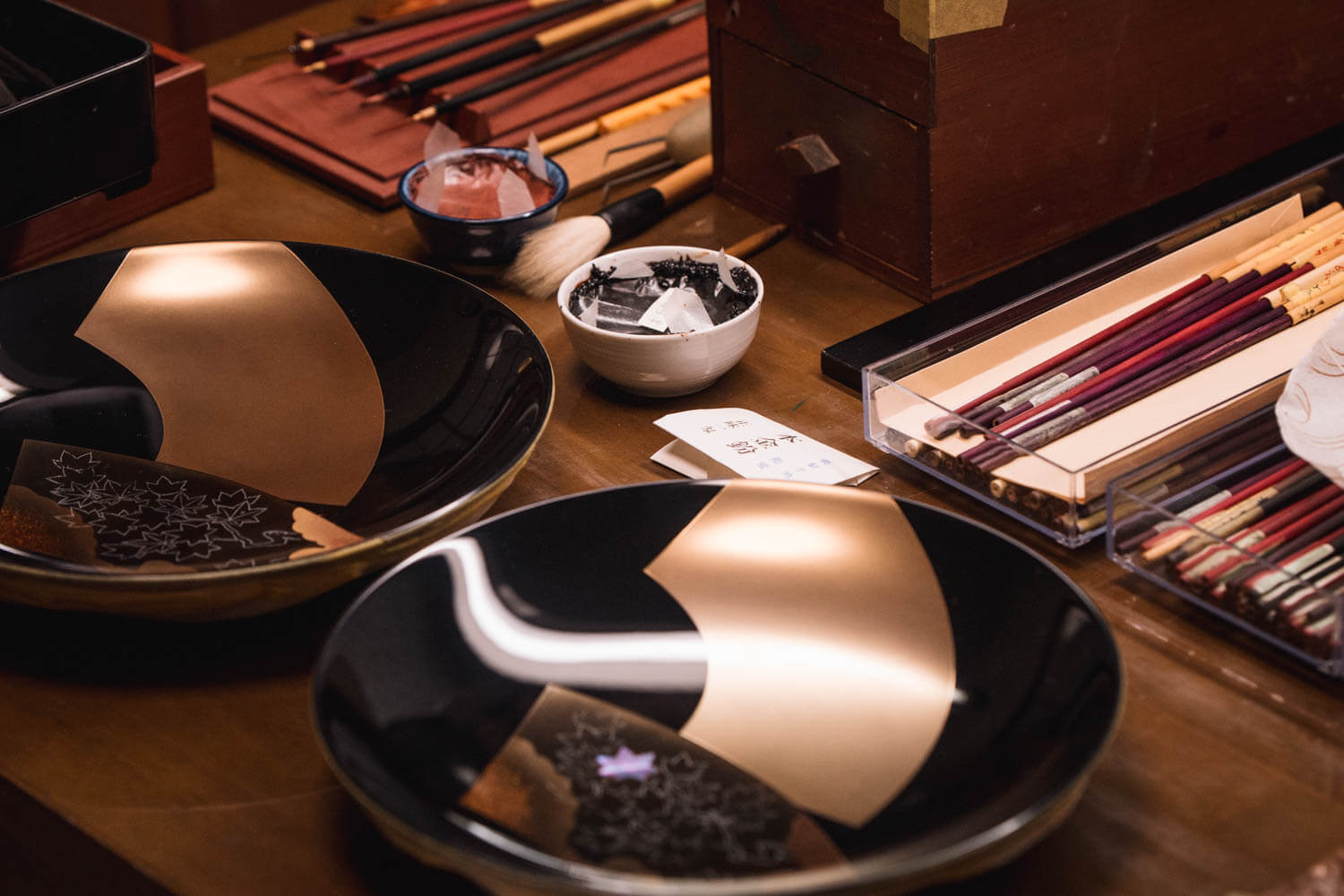
Maki-e (蒔絵), which translates literally into “sprinkled pictures”, is a Japanese lacquerware technique that weaves together lacquer patterns and shimmering powders of precious metals. Born around 1200 years ago during the Heian period (794-1187), it is achieved by painting intricate lacquer designs onto a surface and sprinkling these fine powders onto its still-wet surface. Maki-e’s three main techniques include tokidashi maki-e, hiramaki-e, and takamaki-e. The craftsman’s choice of technique, or a fusion thereof, then depends on the complexity of the design. Initially a luxury exclusive to court nobles, possessions embellished with Maki-e gradually became a symbol of power for families and military leaders in the Edo period (1603-1868). Today, Maki-e graces the everyday and the extraordinary, from tableware to timepieces, enchanting luminaries from the Japanese Imperial family to Barack Obama and Ronan Bouroullec.
Recently, we at Kyomi had the honor of witnessing the master craftsman Minori Koizumi breathe life into his Maki-e creations. A journey of seven steps, each demanding unwavering care and patience, we invite you to join us as we unravel the mysteries of Maki-e:
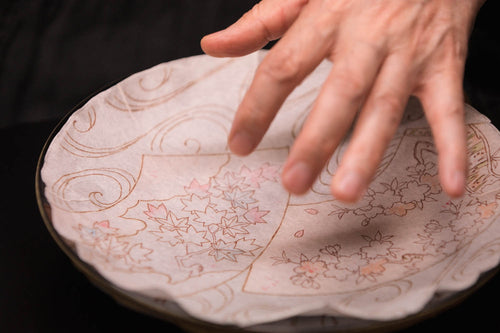
Transforming Ideas to Urushi Lacquer
Using Urushi lacquer, the product’s design is painted on paper to create a blueprint. This first draft is essential for ensuring consistent quality across all products.
For some luxury commissions, Mr. Minori may be given a specific design or image to follow. Zodiac animals, for example, are commonly requested motifs for gifts on milestone birthdays. On other occasions, he may receive a general request, allowing him the freedom to create his own designs.
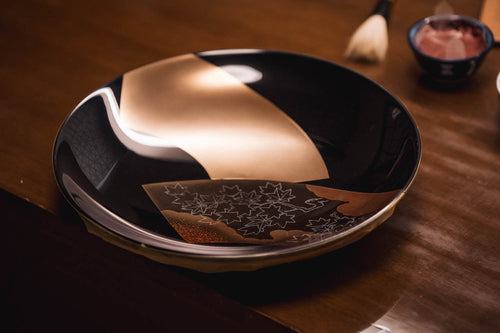
From Blueprint to Embellishment
By gently pressing the blueprint against the product with a brush, the design is embossed onto its surface. White powder is then gently applied to accentuate the design and allow for easier painting.
Mr. Minori's collection of brushes, each unique in its thinness and roughness, is a testament to the rarity and precision of Maki-e painting. Currently, there are only around three manufacturers of Maki-e brushes in Japan, making even the equipment needed for this technique a rarity.
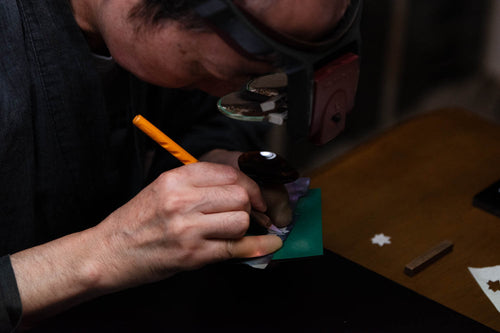
Merging Shells and Lacquer in Harmony
For this particular design, Mr. Minori combines Maki-e with the technique of Raden (螺鈿), where an ultra-thin layer of shiny mollusk shell lining (otherwise known as mother-of-pearl) is pasted onto a lacquerware surface to form part of its design. The shape of a momiji (紅葉) leaf (red autumnal leaf) is then outlined on paper, pasted onto the shell lining, and precisely carved with a small razor blade.
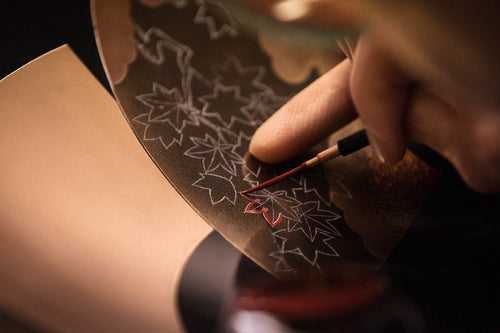
Painting the Foundation of Artistry
With the white powder-coated design as a reference, the shape of the same momiji leaf is painted onto the product’s surface with lacquer paint with a fine brush. This forms the base for which the shell-lining leaf will be pasted onto the product. The lacquer takes precisely two hours to dry, and at the tail end of this process, the leaf must be pasted onto it right before it hardens.
In Maki-e, Urushi lacquer serves two functions; as decorative paint and as a glue to bind other materials onto the product’s surface. Even when the lacquer is used as glue, the craftsman’s brush must maintain a perfectly consistent pressure to draw precise lines. Any hesitation will result in the lacquer seeping out from under the shell lining and affecting the design. This is made even more challenging by the fact that the Maki-e brush can only be used in one ‘pulling’ direction. In other words, this technique demands perfection on the first try — no corrections are possible, and the slightest mistake will drastically affect the final results.
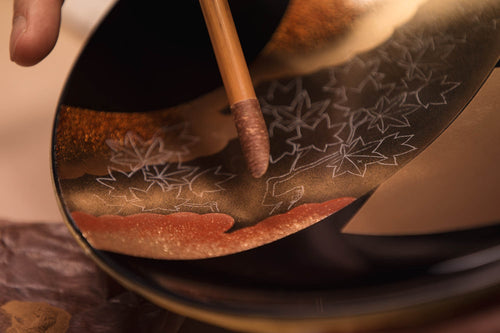
Conjuring Texture and Depth with Precious Powders
Here is where the magic of Maki-e occurs. Using a small brush, the powdered precious metal is gently dusted from a bamboo flute onto the lacquer design. Through a combination of flicking and brushing, distinct textures are created to give the illusion of depth and three-dimensionality.
The three main types of powder include gold, silver, and platinum, all of which are specially manufactured in a separate gold powder store. As each has a different degree of roughness, the craftsman may use a unique combination of powders to create different effects. An alloy of gold and silver creates a gold powder with a blue tint known as aokin (青金) or ‘blue-gold’. Gold, Maki-e’s signature color, is a particularly popular choice amongst customers because it appears brighter on the lacquerware surface and catches the eye.
For this product, gold powder of different sizes and roughness was chosen for different areas of the design. While the rougher powder creates a glittery effect that highlights the base of the clouds, the fine powder scattered along their edges produces an even surface of matte gold, lending a sense of depth and multi-dimensionality to the design.
What is unique to Mr. Minori’s style of Maki-e is how he utilizes the different powders to strike a balance between the real and the abstract. As he explained to Kyomi in an interview, his aim is not to create realistic designs but to distill the essence of a subject. His approach, atmospherical and evocative, is embedded within the fabric of the Maki-e technique itself. Dusted lightly onto the lacquer drawings, the glistening powder serves not to dominate but to accentuate its contours, illuminating the areas where light falls or shadows gather in a shimmering haze. This technique imparts an air-brushed quality that is perfect for suggesting a sense of transience yet paradoxical timelessness. Breath-like, gold blooms across the dark lacquerware, reminiscent of an Impressionist painting — little wonder, given that the artists of this movement took much inspiration from Japanese prints in the 1860s to 1880s.
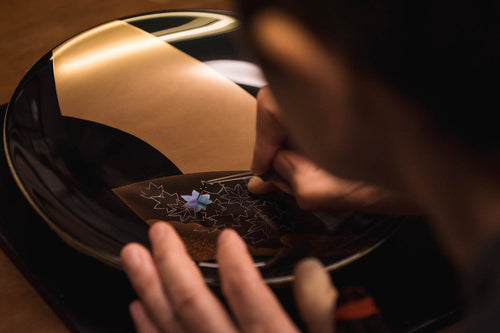
Sealing the Radiant Design
After the lacquer has completely dried and the powder is fused to the surface, another layer of lacquer is applied. After around two more hours of drying, a transparent layer of lacquer is applied for the final coating.
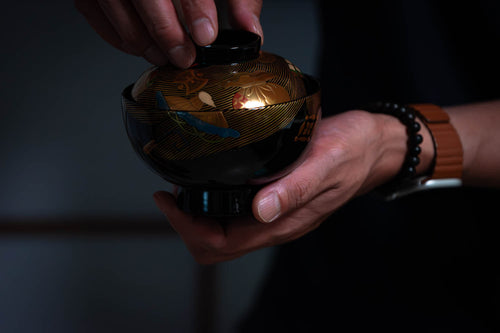
Polishing to Perfection with Tsubaki Charcoal
The final product is polished with Tsubaki (椿) charcoal, charcoal pieces made from camelia wood, to smoothen its surface and allow it to shine.
When observing Mr. Minori’s Maki-e process, what struck us most was the painstaking detail he dedicates to every piece. For a surface the size of a wristwatch, Mr. Minori is, as of now, the only person in Japan who can create miniature paintings so detailed that you can see the fine hairs along a rabbit’s spine or the texture of a tree’s leaves when they are held against the light. With his tremendous skill, his focus is no longer on what level of detail is possible but on when to stop. During his interview, his colleague credited it to his careful, detail-oriented personality. Mr. Minori smiled and replied, “It was just the years of training.”
Apart from painting new Maki-e designs, Mr. Minori is also involved in repair work, re-painting broken lacquerware and glasses to restore them to their original condition. He often receives requests to fix them via Kintsugi (金継ぎ) or "golden joinery" — the famous technique of mending broken pottery with lacquer dusted with gold. When interviewed, Mr. Minori explained that the philosophy of Kintsugi is deeply rooted in Japanese culture, particularly in the teachings of Mottainai (もったいない ) or ‘no waste’. As pottery and lacquerware products are very expensive, Kintsugi provides a means to preserve their functionality while embracing their newfound beauty. It is a philosophy that treats the process of breakage and repair as a significant part of the object’s history, accepting the change and flaws that come with it.
In the end, Maki-e is not just a technique, but a quiet celebration of craftsmanship. With each stroke, a testament to the craftsman’s enduring patience and precision, we are reminded that the pursuit of art is a journey — sometimes an odyssey of light and lacquer, of the transient and the timeless, and sometimes a pilgrimage through one’s history and culture. As a philosophy, Maki-e reminds one to slow down and find beauty in the details. No matter where you find yourself in this world, may these momiji leaves cast their glittering shadows upon your table, still golden from the touch of a lingering summer.
Ready to explore our wide range of products? Visit our catalog page now and discover the perfect items for your needs!
